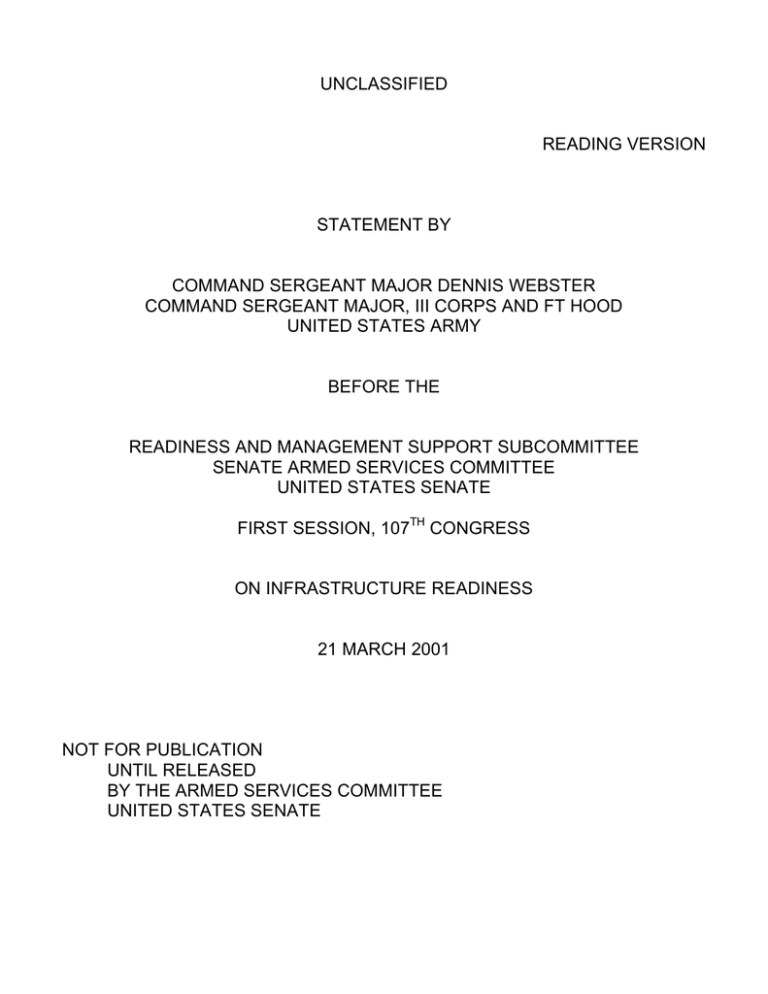UNCLASSIFIED READING VERSION STATEMENT BY COMMAND SERGEANT MAJOR DENNIS WEBSTER
advertisement

UNCLASSIFIED READING VERSION STATEMENT BY COMMAND SERGEANT MAJOR DENNIS WEBSTER COMMAND SERGEANT MAJOR, III CORPS AND FT HOOD UNITED STATES ARMY BEFORE THE READINESS AND MANAGEMENT SUPPORT SUBCOMMITTEE SENATE ARMED SERVICES COMMITTEE UNITED STATES SENATE FIRST SESSION, 107TH CONGRESS ON INFRASTRUCTURE READINESS 21 MARCH 2001 NOT FOR PUBLICATION UNTIL RELEASED BY THE ARMED SERVICES COMMITTEE UNITED STATES SENATE COMMAND SERGEANT MAJOR DENNIS E. WEBSTER COMMAND SERGEANT MAJOR DENNIS E. WEBSTER WAS BORN IN WISCONSIN AND ENTERED THE UNITED STATES ARMY FROM ARKANSAS IN APRIL 1972. HE WAS A STUDENT AT ARKANSAS STATE UNIVERSITY FOR TWO YEARS PRIOR TO HIS ENLISTMENT. HE ATTENDED BASIC COMBAT TRAINING AT FORT POLK, LOUISIANA, FOLLOWED BY ADVANCED INDIVIDUAL TRAINING AS AN ARMOR CREWMAN AT FORT KNOX, KENTUCKY. COMMAND SERGEANT MAJOR WEBSTER’S MILITARY EDUCATION INCLUDES DRILL SERGEANT SCHOOL, THE ADVANCED NONCOMMISSIONED OFFICERS’ COURSE AND THE FIRST SERGEANTS’ COURSE. HE IS ALSO A GRADUATE OF CLASS 32 OF THE UNITED STATES ARMY SERGEANTS MAJOR ACADEMY. COMMAND SERGEANT MAJOR WEBSTER’S ASSIGNMENTS INCLUDE NUMEROUS POSITIONS IN ARMOR AND CAVALRY UNITS FROM TANK LOADER TO PLATOON SERGEANT; DRILL SERGEANT AT FORT KNOX, KENTUCKY; PROFESSIONAL DEVELOPMENT NONCOMMISSIONED OFFICER FOR ARMOR AT THE MILITARY PERSONNEL CENTER IN ALEXANDRIA, VIRGINIA; FIRST SERGEANT IN AN ARMOR BATTALION IN THE 3D INFANTRY DIVISION, KITZINGEN, GERMANY; ENLISTED ADVISOR TO THE 69TH INFANTRY BRIGADE OF THE KANSAS ARMY NATIONAL GUARD; COMMAND SERGEANT MAJOR OF THE SUPPORT SQUADRON, 3D ARMORED CAVALRY REGIMENT, FORT BLISS, TEXAS, DURING DESERT SHIELD AND DESERT STORM; COMMAND SERGEANT MAJOR OF 3D SQUADRON, 3D ARMORED CAVALRY REGIMENT AND REGIMENTAL COMMAND SERGEANT MAJOR OF THE BRAVE RIFLES. HE SERVED AS COMMAND SERGEANT MAJOR OF THE 11TH ARMORED CAVALRY REGIMENT, FORT IRWIN, CALIFORNIA AND AS THE COMMAND SERGEANT MAJOR OF THE 1ST CAVALRY DIVISION, FORT HOOD, TEXAS. HE CURRENTLY SERVES AS THE COMMAND SERGEANT MAJOR OF III CORPS AND FORT HOOD, FORT HOOD, TEXAS. HIS AWARDS AND DECORATIONS INCLUDE THE LEGION OF MERIT, THE BRONZE STAR MEDAL, THE MERITORIOUS SERVICE MEDAL WITH FOUR OAK LEAF CLUSTERS, THE ARMY COMMENDATION MEDAL WITH TWO OAK LEAF CLUSTERS, AND THE ARMY ACHIEVEMENT MEDAL WITH TWO OAK LEAF CLUSTERS. COMMAND SERGEANT MAJOR WEBSTER WAS INDUCTED INTO THE USAREUR SERGEANT MORALES CLUB IN 1979 AND IS AN HONORARY MEMBER OF THE SERGEANT AUDIE MURPHY CLUB. COMMAND SERGEANT MAJOR WEBSTER IS MARRIED TO THE FORMER SANDRA JENNINGS OF MOUNTAIN HOME, ARKANSAS. THEY HAVE TWO CHILDREN. STATEMENT BY COMMAND SERGEANT MAJOR DENNIS WEBSTER COMMAND SERGEANT MAJOR III CORPS AND FT HOOD ON INFRASTRUCTURE READINESS Good morning, I am Command Sergeant Major Dennis Webster. I am the Command Sergeant Major for the U.S. Army III Corps and Ft. Hood, Texas. Thank you all for the opportunity to speak to you this morning. This opportunity to speak to you this morning is very important to me – Your understanding and support of our installations and our soldiers and civilians is vital to the Army’s mission and overall operational readiness. III Corps is the most powerful Armored Corps in the world – 75,500 soldiers – 24,000 combat vehicles and aircraft—37% of all U.S. active component ground combat power. It includes forces at four major installations: Fort Hood, Fort Carson, Fort Bliss and Fort Sill, also with oversight at Fort Riley. During these opening remarks, I will focus on issues at Fort Hood, but in general, the same problems exist at all our installations. Fort Hood is considered the power projection platform of the Army – the knockout blow when the world needs us. We must be prepared to respond to any threat, anywhere in the world, when called upon. Unfortunately, this is becoming more and more difficult because the demands placed on the infrastructure that supports our units, our soldiers, our civilians and our families. The Army, over the years, has attempted to juggle well-being needs and initiatives while trying to maintain readiness. As it should be, the priority has been our ability to fight and win our country’s wars, but the price has been a shortfall in the maintenance of our installation infrastructure. Fort Hood is a maintenance challenge! It has the equivalent of four Pentagons’ worth of buildings. This includes 99 barracks, 56 motor pools, and nearly 6,000 sets of family quarters, more than 400 miles of water lines, 280 miles of waste water lines, 260 miles of gas lines, 900 miles of paved roads, 1,700 acres of paved parking. Fort Hood is BIG! We have over 340 square miles on the installation. We are the home to over 42,000 soldiers and supporting over 166,000 family members and retirees. At Fort Hood, we have a comprehensive RPM program that includes repairs, preventive maintenance, and the life cycle replacement of components. Under the Army’s Installation Status Report (ISR) facilities are assessed against DA condition standards for each type of facility. “Red” facilities are described as dysfunctional and in overall poor condition. Of the 44 barracks renovated on Fort Hood during FY90-95, 25 (67%) are now rated Amber or Red in the ISR. The FY01 requirement for real property maintenance and repair at Fort Hood is estimated at $204 million to bring facilities to standard. The current funding level of $16.4 million basically limits efforts to Priority 1 repairs. Priority 1 repairs include health protection, safety, security, or the prevention of property damage. Examples include gas leaks, sewage backups, heat, airconditioning, and power failures. On a positive note, our construction program for new facilities represent improved conditions for our soldiers, but they also represent more space, more components and more technically complex systems to maintain. New barracks now have individual sleeping rooms, multiple bathrooms, and individual heating and cooling systems compared to the old sleeping bays, gang latrines, and centralized systems. Despite the many new facilities, the average building on Fort Hood is nearly 30 years old. Funding levels have never allowed for a comprehensive approach that included adequate and systematic preventive maintenance and component replacements. Steady progress has been made over the years, and this encourages soldiers, particularly ones who have returned to Fort Hood after other tours. But since the RPM focus has to be, of necessity, on Priority 1 items, those items that soldiers see on a daily basis end up on the backlog. Let me give you a few examples. When we look at where soldiers work, several items are readily apparent. The average life expectancy for roofs on Fort Hood is 15 years. Lack of funds drives the decision to “patch” rather than replace. At the average cost of $59,000 per roof, Fort Hood should be spending nearly $9 million per year on roof replacements for the 2,272 non-housing buildings. The problem compounds with each year facilities are not fully maintained. Maintenance shop bay doors and bay lights are prime examples of the impact of deferred maintenance on the installation’s ability to perform its mission. Over 160 bay doors currently need repair or replacement. More than 1,300 bay lights are inoperable. A recent inspection of 194 hangar doors at the two airfields revealed that 104 need repair immediately. When we look at where soldiers live, there are different, but no less important issues. For example, over 5,000 locks in barracks need repair or replacement today. Excessive wear without replacement means the same key opens multiple doors and soldiers’ safety and security are compromised. When we take an even larger view of things that the average soldier doesn’t consider until there is a failure somewhere, other issues become apparent. A large portion of our water lines, waste water lines, and gas lines is part of the original distribution systems for Fort Hood and is more than 50 years old. With a 40 to 50-year life expectancy , these systems are deteriorated and failing frequently. Fort Hood repaired four water line breaks for 10-16” water lines in just one week this year. Annual replacement investment exceeds $5 million for these items alone. I’m sure you are all aware of the current state of our family housing. There are initiatives in all the services to address these shortfalls. We at Fort Hood have our Residential Communities Initiative (RCI) to address our family housing shortfall and maintenance. We have begun to think “outside of the box” to address problems we are facing and RCI is an excellent example; however, many times when we think “outside of the box” we need additional approvals to execute, and in this I would ask your help. The facilities at Fort Hood play a key role in the military readiness equation. The continued choice to patch roof leaks rather than replace roofs jeopardizes facilities and costly computer equipment, furniture, and carpeting – we end up being “penny wise, pound foolish.” Soldiers lose confidence in their leaders because of perceived indifference or inability to take care of their needs. Our soldiers and civilians and their families are negatively impacted in the places they work, live, and play. In conclusion, I am extremely proud of our soldiers and civilians; I am proud to represent them. I thank you on behalf of all III Corps soldiers, civilians, and family members for your past support and look forward to the opportunity to discuss and solve together the challenges that lie ahead.






